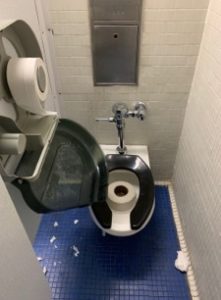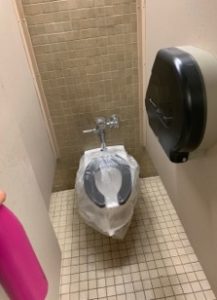Flush Away Your Powder Room Problems:
Proposing a Solution to Renovate CCNY’s Outdated Bathroom Facilities
Introduction
Having clean bathrooms on campus is a student’s right, not a privilege. It is very important to have clean, safe, and user-friendly bathrooms since many students spend the majority of their day on campus. Implementing cleaner bathrooms is extremely important because it can be detrimental to students’ overall health. Dirty bathroom facilities are filled with contaminants that can get students sick and prevent them from properly learning and studying.
A survey that consisted of 25 students asked the question “If you had to rate how nice the bathrooms are, would you say they are: Good, Okay, Bad or Very Bad,” 52% of students either voted “Bad” or “Very Bad.” 52% of students would also consider a raise in tuition if it meant creating cleaner bathroom facilities. If bathroom facilities remain in the condition they are now, CCNY students will ultimately suffer. This is a major issue because a students’ grades can be negatively affected by their overall health, which could be a direct result of unclean bathrooms.
Bathrooms are constantly out of service or are too unwelcoming to use. This proposal outlines four main steps needed to put this plan into action, which includes recognizing the poor maintenance and conditions of CCNY’s ill-equipped bathrooms, observing what required upgrades are needed to fix these issues, learning how to save resources for the future, and coming up with a few unique ways to remind users of their responsibility to keep the bathrooms clean.
Figures 1-4 demonstrate the below average conditions of the bathroom facilities at CCNY.




Project Plan
Step 1: Recognizing the issues students face because of poor bathroom facilities
Poor maintenance and ill-equipped bathrooms:
As soon as someone enters the bathroom, he/she is prone to get contaminated by germs left behind by the previous user. Poor maintenance, outdated and ill-equipped tools are the cause of unhygienic bathrooms.
Often we come across a stall where toilet paper was thrown into the toilet or left unflushed. Consequently, no one would use that inadequate stall until its clean and useable. Some of the faucets are impractical because one needs to press and hold on to the knob of the faucet to get water. So, when someone needs to wash their hands, they are left with no choice but to use one hand to hold on to the knob to wash another hand. This means that it is impossible to wash both hands together at the same time, which is very unhygienic. In short, each time a student touches the faucet or flush valve, a door knob, toilet stall walls, doors, or soap and paper towel dispensers, there is a possibility of germs contamination that’s left behind by previous users.
Due to poor maintenance, paper towel and soap dispenser aren’t refilled often. It is very common to see used as well as unused paper towels on the floor or next to the sinks. This contributes to unsanitary bathroom conditions. Often someone spills water on the floor and doesn’t clean it and then others walk over the water leaving the floor dirty. This can also pose as a safety hazard because it result in a slip or fall.
Cleanliness of the bathroom facilities is a huge concern that is being neglected. Additionally, the lighting in some of the bathrooms are very dimmed. This makes the bathroom look more unclean and unwelcoming. Another huge issue is the lack of ventilation, causing unpleasant odors to stay in the bathroom. Also, none of the bathrooms have any cabinets with essential sanitary products such as toilet paper or paper towels.
Step 2: Possible solutions to improve bathroom facilities for the students
Required Upgrades:
The bathrooms are cleaned three times a day by CCNY staff. However, this maintenance does not prove to be sufficient to clean everything properly. There are constant issues with unpleasant odor, out of stock toilet paper and overall griminess of the facility. To avoid uncleanliness and poor maintenance, bathrooms should be cleaned at least four times per day. So, it is important to increase one or two staff members per shift.
The bathrooms should have more upgraded tools to provide students with more adequate facilities. A major issue are the faucets. The knobs of the faucets should be changed. These knobs can be replaced by regular knobs or motion sensor faucets. Sensors can be used in many aspects of the bathroom to combat this issue and avoid contamination. For instance, a sensor in a toilet detects when the user has moved away and flushes automatically. This allow users to flush hand free and ensures that the toilet is properly flushed for the next user. Adding more hand dryers would also be useful to limit paper towel waste. Also, to avoid paper towels being thrown on the floor or sink, garbage cans should be placed right below the towel dispensers. Lighting can also make a huge difference. Bright lights can make a space look cleaner and welcoming. To to get rid of the unpleasant odor, bathroom vent/exhaust fans should be installed. This is very effective and economically friendly compared to adding a whole new ventilation system via construction. The exhaust fans are simple. These mechanical ventilation devices draw out humid, unpleasant odors from the bathroom, which would improve the air quality and freshness of the bathroom. Overall, by installing clean, new bathroom equipment and increasing the number of visits maintenance cleaning crews take to the bathroom facilities, many of the issues with the bathrooms can be solved.
Step 3: Possibilities of conservation of energy and resources
Saving resources for the future:
Sensors in the faucets and soap/towel dispensers will help to save resources. Precisely, sensors on soap/towel dispensers release a specific amount of product can help avoid unnecessary waste of soap and paper towels. Increasing more hand driers will also decrease paper towel usage and save resources. Excessive water flow in the faucets can also be minimized by using the low-flow aerators and automatic shutoffs. As a result of these bathroom changes, we can limit the spending on paper towels and running water to conserve resources more efficiently.
Step 4: Encouraging users to maintain good bathroom facilities
Unique ways of reminding users their responsibility:
Keeping the bathrooms clean should not be the responsibility of the staff. Users should also have respect for their cleanup to ensure more hygienic bathroom facilities. To encourage students to fulfill their responsibility, small murals (painting/art work) can be very effective as well as aesthetically pleasing. For example, reminders such as “do the right thing even when no one is watching”, “choose kindness and respect”, “did you wash your hands?” will encourage cleanliness, while use of bright colors will break the monotony as vibrant touches make students feel happy. Many clubs on campus would be open to volunteer to create these murals, so there’s no need of extra budget for this project.
Costs and Benefits
The cost and benefit analysis applies for the bathrooms located in the Grove School of Engineering. There is a total of 12 bathroom facilities on the main engineering floors (6 main floors, one women’s and one men’s restroom per floor).
|
Number of Bathrooms |
Non-sensor Faucets (48 units) |
Sensor Faucets (48 units) |
Urinals (24 units) |
Hand Dryer (24 units) |
Foam Soap Dispenser (36 units) |
Vents (120 units) |
| 12 | $9,447 | $14,400 | $6,622 | $9,600 | $1,152 | $14,400 |
| Number per Bathroom | 4 per bathroom | 4 per bathroom | 4 per bathroom* | 2 per bathroom | 3 per bathroom | 10 per bathroom |
| Overall Cost including labor | $16,647 | $21,600 | $13,822 | $10,800 | $2,052 | $22,440 |
* Men’s Bathroom Only – 6 bathrooms total
Three renovation plans have been organized to offer three options for the bathroom proposal:
Basic Plan
The Basic Plan would include the basic upgrades needed for bathroom renovations. This includes new:
Non-sensor Faucets: $16,647
Vents: $22,440
Hand Dryers: $10,800
This would be a total renovation of $49,887
Premium Plan
The Premium Plan would include major upgrades for bathroom renovations. This includes new: Sensor Faucets: $21,600
Vents: $22,440
Hand Dryers: $10,800
This would be a total renovation of $54,840
Gold Plan
The Gold Plan would include the most upgraded bathroom renovations. This includes new: Sensor Faucets: $21,600
Vents: $22,440
Hand Dryers: $10,800
Foam Soap Dispensers: $2,052
Urinals: $13,822
This would be a total renovation of $70,714
Regardless of which plan is chosen, each cost a reasonable amount of money. The benefits of even the Basic Plan allow for better ventilated restrooms and more hygienic hand washing and drying stations.
Team Biography
Tanziba Tashima is a sophomore majoring in chemical engineering at The City College of New York with a current GPA of 3.6. Along with strong writing and interpersonal skills, data management skills in a pharmaceutical setting, she is proficient in Matlab, Microsoft Word, Excel and PowerPoint. She worked as a customer service representative in An – Noor Pharmacy and was responsible for taking customer’s medication orders, ensuring accuracy of customers’ data and reporting. As an administrative assistant at The Grove School of Engineering, she assisted Associate Dean of The Academic Affairs with scheduling and coordinating appointments, responded to telephone and in-person requests for information and tabulated data from forms, filed it, and entered it into spreadsheets and reports. Some of her many awards include New York State Scholarship for Academic Excellence (2016 to present), Outstanding Academic Achievement Award (Spring,2018), Presidential Award for Academic Excellence (2016), National Honor Society (Arista) Award for Excellence (2013 to 2016). As a passionate member of the community, she volunteered for CCNY and Grove School Commencement ceremony of June 2018 and collected donations and increased awareness for Breast Cancer and Heart Diseases as a member of Key Club (2013 to 2016). She is an active member of CCNY Bangladesh Student Association and CCNY Habitat for Humanity.
Sabrina McCarthy is a fifth year chemical engineering student at The City College of New York. She has had extensive experience in both work and leadership positions. Sabrina has interned at Johnson & Johnson and has done international research at KTH’s Royal Institute of Technology in Stockholm, Sweden. She presented her research from Sweden and competed against 300 participants at the 2017 AICHE International Poster Competition and was awarded 1st place in the Food, Pharmaceutical and Biotechnology category, ranking in the top 10th percentile of student presenters. She has also utilized her entrepreneurial and communication skills when she worked at Lucille Roberts Gym to generate and save more than 50 clients over a 6–month period by promoting gym upgrades and deals, which ultimately maximized company revenue. Sabrina is also very active on campus. She founded and established the 1st ever Year Coordinator branch of AICHE and grew club participation by 5x. She built successful relationships between professors and students by organizing 3 major events per semesters with over 60 people in attendance. Outside of school, Sabrina is a judo coach with over 12 years of experience. She instructs 10 to 20 junior-judo competitors during practice and ensures they learn the basic fighting skills needed for competition. Overall, Sabrina is a very enthusiastic and driven person with future goals of becoming a consultant at a firm like McKinsey & Co. or Accenture.
Yossr Korban is a first year student, studying Biomedical Engineering at The City College of New York. She spent her summer in 2017 studying at Queens College, earning a Mathematics and Science certificate. She has also volunteered at two clinics and a hospital, helping doctors, nurses and pharmacists provide their patients with the best care possible. Spending her summer as a volunteer at Flushing Hospital Medical Center, she learned a few of the many ways doctors and nurses strive to provide excellent care for patients in all departments. Yossr got a closer look at the patients at the Substance Abuse Department and was able to work with them directly. This humbling experience influenced her work ethic tremendously. At the two other clinics Yossr volunteered at, she gained clerical experience when assisting doctors and nurses filing paperwork. Yossr is fluent in English, Arabic and working on improving her Turkish.
Ahmed Said is a first year Mechanical Engineering student at the City College of New York. His passion for engineering came from his love for mathematics. Not only did Ahmed enjoy this subject but he also spread his talent to other individuals by tutoring Algebra, Geometry, Trigonometry and SAT Math at Bobby Learning Tutoring Center. He also tutored in his High School, Long Island City. Ahmed also gained experience in customer interaction by volunteering at Dr. Mohamed Salah’s office as a (Nuero in Motion) assistant in the summer of 2017. Ahmed conducted a study in Egypt in the summer of 2017 with help of the Green Marketing Agency. This study included performing market research, by setting up informational stands in Cairo to gauge at the population’s interests. Ahmed also interacted and informed many potential clients and the general population, collecting data to aid in the company’s needs. Ahmed looking forward to self-growth as he gains experience from his college career and promises big innovations in the future.






